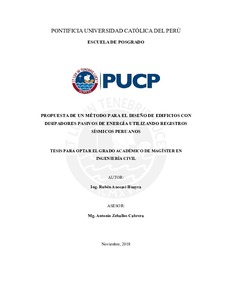| dc.contributor.advisor | Zeballos Cabrera, Antonio | |
| dc.contributor.author | Anccasi Huayra, Rubén | es_ES |
| dc.date.accessioned | 2020-01-17T18:16:16Z | |
| dc.date.available | 2020-01-17T18:16:16Z | |
| dc.date.created | 2019 | |
| dc.date.issued | 2020-01-17 | |
| dc.identifier.uri | http://hdl.handle.net/20.500.12404/15598 | |
| dc.description.abstract | La presente investigación se ha desarrollado siguiendo los lineamientos planteados por la Sociedad Americana de Ingenieros Civiles (ASCE) y por la Agencia Federal para el Manejo de Emergencias (FEMA). El método de diseño consiste en realizar un análisis dinámico no lineal tiempo historia, para lo cual se empleó el software SAP2000, basado en la filosofía de diseño por desempeño propuesto por la Sociedad de Ingenieros Estructurales de California (SEAOC) a través del Comité Visión2000.
Con la finalidad de comparar el desempeño estructural y los costos de construcción, se eligió un edificio ubicado en la ciudad de Lima, cuyo uso es esencial. El edificio tiene cuatro niveles y presenta una configuración regular en planta y elevación. El sistema estructural está conformado por pórticos de concreto armado y una losa maciza de 20cm de espesor. El edificio no cumple por desplazamientos laterales, pero sí por resistencia de acuerdo a los límites establecidos en el Reglamento Nacional de Edificaciones (RNE). Como solución se propuso dos alternativas, una solución no convencional que consistió en incorporarle disipadores de energía y una solución convencional que consistió en incrementar el tamaño de las columnas y vigas hasta lograr que el desempeño esperado de ambos edificios sean similares. Ambos edificios llegaron a un desempeño operacional y resguardo de vida para el sismo de 475 y 970 años de período de retorno, respectivamente. Se verificó que la diferencia de costos de construcción es de $1.29/m2, siendo el edificio no convencional el más económico. Ambas soluciones cumplen con el desempeño esperado. | es_ES |
| dc.description.abstract | This research has been carried out following the guidelines proposed by the American Society of Civil Engineers (ASCE) and Federal Emergency Management Agency (FEMA). The design method consists in performing a dynamic nonlinear time history analysis, for which the SAP2000 software was used, based on the philosophy of performance design proposed by the Structural
Engineers Associations of California (SEAOC) across the Vision2000 Committee.
In order to compare the structural performance and the construction costs, a building located in the city of Lima was chosen, its use is essential. The building has four levels and has a regular configuration in plan and elevation. The structural system consists of reinforced concrete frames and a slab of 20cm of thick. The building does not comply with the lateral displacements, but by strength according to the limits established in the Peruvian Code (RNE).
As a solution, two alternatives were proposed, an unconventional solution that consisted of incorporating energy damping and a conventional solution that consisted in increasing the size of the columns and beams until the expected performance of both buildings is similar. Both buildings should have an Operational and Life Safety performance for an earthquake of 475 and 970 years of return period, respectively. It was verified that the difference in construction costs is $ 1.29 / m2, with the unconventional building being the most economical. Both solutions fulfill with the expected performance. | es_ES |
| dc.description.uri | Tesis | es_ES |
| dc.language.iso | spa | es_ES |
| dc.publisher | Pontificia Universidad Católica del Perú | es_ES |
| dc.rights | info:eu-repo/semantics/openAccess | es_ES |
| dc.rights.uri | http://creativecommons.org/licenses/by/2.5/pe/ | * |
| dc.subject | Análisis estructural (Ingeniería) | es_ES |
| dc.subject | Construcción--Costos | es_ES |
| dc.subject | Construcciones de concreto armado--Protección | es_ES |
| dc.subject | Ingeniería antisísmica | es_ES |
| dc.title | Propuesta de un método para el diseño de edificios con disipadores pasivos de energía utilizando registros sísmicos peruanos | es_ES |
| dc.type | info:eu-repo/semantics/masterThesis | es_ES |
| thesis.degree.name | Maestro en Ingeniería Civil | es_ES |
| thesis.degree.level | Maestría | es_ES |
| thesis.degree.grantor | Pontificia Universidad Católica del Perú. Escuela de Posgrado | es_ES |
| thesis.degree.discipline | Ingeniería Civil | es_ES |
| renati.advisor.dni | 10223506 | |
| renati.advisor.orcid | https://orcid.org/0000-0002-4053-9073 | es_ES |
| renati.discipline | 732267 | es_ES |
| renati.level | https://purl.org/pe-repo/renati/level#maestro | es_ES |
| renati.type | http://purl.org/pe-repo/renati/type#tesis | es_ES |
| dc.publisher.country | PE | es_ES |
| dc.subject.ocde | https://purl.org/pe-repo/ocde/ford#2.01.01 | es_ES |






